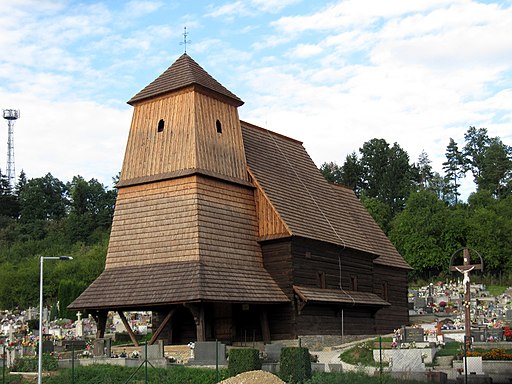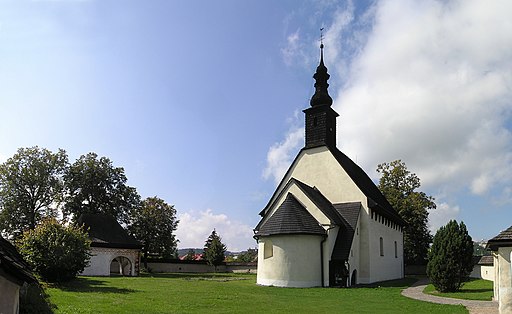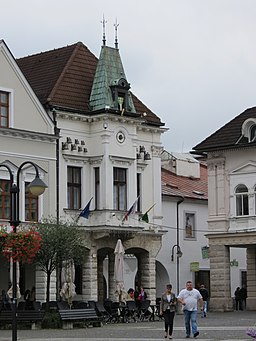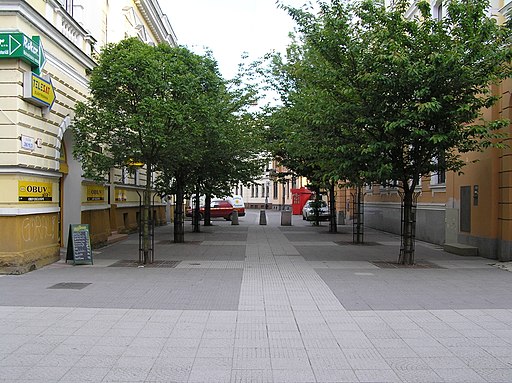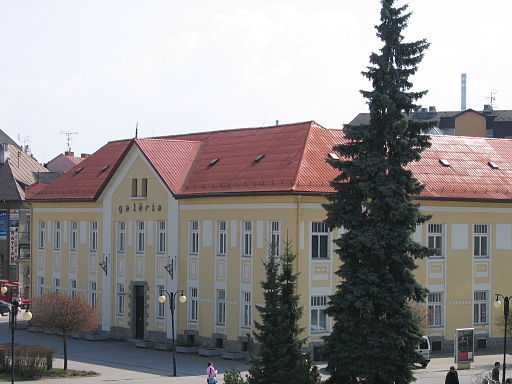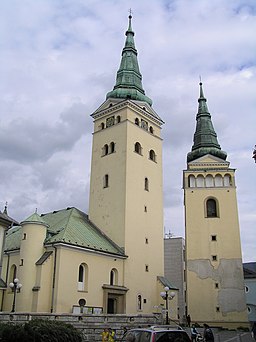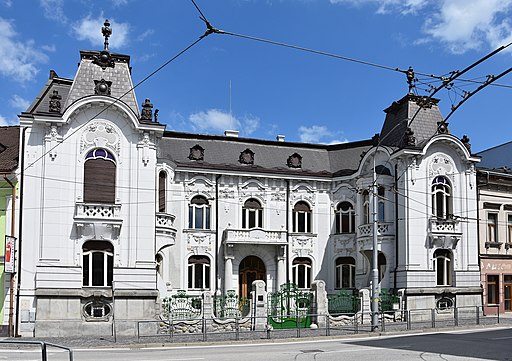Zsolna
Historical Hungarian county:
Trencsén
GPS coordinates:
49.223383, 18.739416
Population
Population in 1910
| Total |
9179 |
| Hungarian |
25.45% |
| German |
15.94% |
| Slovak |
53.97% |
Coat of Arms
© Lukáš Lalinský / Wikimedia Commons
/ CC BY-SA 2.5
After the destructions of the Mongol Invasion King Béla IV of Hungary invited German settlers to the area. In 1321 King Charles I of Hungary granted the settlement the status of free royal town. His son, King Louis I of Hungary granted equal rights to the Germans and the Slavs living in the town. It was burned down twice by Czech Hussite marauders in the 1430s, the Germans disappeared and the town began to decline. In 1848, during the Hungarian War of Independence, the burghers of the town refused to supply the Austrian army, and the army led by Beniczky Lajos defeated Hurban, who broke into Hungary from Galicia with his army recruited from Slovak peasants in order to help the Habsburgs suppress the War of Independence, which most of the Slovak minority also supported. The town developed a lot before First World War. In December 1918, the greedy Czechs, dissatisfied with their own independence, invaded northern Hungary. And in February of the following year, Andrej Hlinka, a former big advocate of the Czech-Slovak unification, agitated in vain in Zsolna, saying that they had to break away from the Czechs, it was already too late. The victorious powers weren't interested in the opinion of the local population.
Check out other towns in Upper Hungary (Slovakia) as well!
895
Arrival of the Hungarians
Little more...
895
The alliance of the seven Hungarian tribes took possession of the then largely uninhabited Carpathian Basin. Until then, the sparse Slavic population of the north-western Carpathians had lived under Moravian rule for a few decades after the collapse of the Avar Khaganate in the early 9th century.
1000
Foundation of the Hungarian Kingdom
Little more...
1000
The Kingdom of Hungary was established with the coronation of King Stephen I. He converted the Hungarians to Christianity and created two archdioceses (Esztergom and Kalocsa) and ten dioceses. He divided Hungary into counties led by ispáns, who were appointed by the king.
1208
The settlement was mentioned for the first time as terra de Selinan. It was the land of the Bishop of Nyitra.
early 13th century
The St. Stephen's church was built.
1241-1242
Mongol Invasion
Little more...
1241-1242
The hordes of the Mongol Empire invaded Hungary and almost completely destroyed it. One third to one half of the population was destroyed. The Mongols also suffered heavy losses in the battle of Muhi and they could not hunt down the king. After their withdrawal, King Béla IV reorganized Hungary. He allowed the feudal lords to build stone castles because they were able to successfully resist the nomadic Mongols. The vast majority of stone castles were built after this. The king called in German, Vlach (Romanian) and Slavic settlers to replace the destroyed population.
after 1242
After the Mongol invasion Germans settled down.
late 13th century
A royal castle was constructed.
1301
The extinction of the House of Árpád
Little more...
1301
The House of Árpád, the first Hungarian royal dynasty, died out with the death of King Andrew III. Hungary was ruled by oligarchs, the most powerful of whom was Csák Máté, whose main ally was the Aba family. King Charles I (1308-1342), supported by the Pope, eventually emerged as the most prominent of the contenders for the Hungarian throne. But it took decades to break the power of the oligarchs.
1312
Zsolna was first mentioned as a town.
1321
King Charles I of Hungary made it a free royal town.
1323
King Charles I created the Castle County of Vágbeszterce. This included the castles of Vágbeszterce, Hricsó, Rajec, Zsolnalitva, Zsolna, Budetin, Óvár, Sztrecsnó. It was owned by the Judge Royal for the duration of his office.
May 7, 1381
King Louis I of Hungary (Louis the Great) granted equal rights to the Germans and the Slavs living in the town.
1382
After the death of King Louis I of Hungary, the Castle County of Vágbeszterce was abolished.
1357
The town was granted the right to hold markets.
1431, 1434
The Czech Hussite marauders burned the town twice, the German population disappeared, and the town started to decline.
1440
After the death of King Albert of the House of Habsburg, the Estates of Hungary elected the Polish Ulászló to the throne. Elisabeth, the widow queen, in order to secure the throne for László, her baby boy, called in the Czech Hussite mercenary leader Jan Jiskra. She gave him the title "Captain of the Mining Towns and Kassa", and gave him the castle of Zólyom.
1440-1441
The Czech Hussites soon occupied much of northern Hungary. They reinforced the castles and turned them into bandit lairs. They were pillaging everywhere and large areas became uninhabited. They wiped out the local German and Hungarian population, who were replaced by Czech and other Slavic settlers. The Czech Hussite devastation largely contributed to the Slavicisation of northern Hungary (now Slovakia).
1462
At the end of the war that King Matthias of Hungary had waged against the Hussites since 1458, Jiskra swore loyalty to the king and handed over the castles he still held. Afterwards Jiskra fought in the service of King Matthias until his death.
after 1490
The town became part of the lordship of Sztrecsény.
1526
Battle of Mohács and the splitting of Hungary into two parts
Little more...
1526
Sultan Suleiman I launched a war against Vienna, instigated by the French. Ferdinand I, Duke of Austria, was the brother-in-law of King Louis II of Hungary. The army of the Ottoman Empire defeated the much smaller Hungarian army at Mohács, and King Louis II died in the battle. A group of the barons elected Ferdinand I of the House of Habsburg to the throne, who promised to defend Hungary from the Turks. He was the younger brother of the most powerful European monarch Emperor Charles V. But the nobility chose the most powerful Hungarian baron, Szapolyai János, who was also crowned as King John I. The country was split in two and a decades-long struggle for power began.
1526
Zsolna lost its status as free royal town.
1541
The Turkish occupation of the capital, Buda, and the division of Hungary into three parts
Little more...
1541
The Turks conquered Buda, the capital of Hungary, after the death of King John I. The central part of the country was under Turkish rule for 150 years. The western and northern parts (including present-day Slovakia) formed the Kingdom of Hungary ruled by the Habsburg emperors. The eastern parts (now mainly under Romanian rule) were ruled by the successors of King John I of Hungary. In 1571, John II (John Sigismund), the son of King John I of Hungary, renounced the title of King of Hungary in favor of King Maximilian of the House of Habsburg, and henceforth held the title of Prince. This formally created the Principality of Transylvania, which was the eastern half of Hungary not ruled by the Habsburgs and was also a vassal of the Ottoman Empire. John II died in 1571, after which the three nations of Transylvania (the Hungarian nobility, the Székelys and the Saxons) elected the prince.
March 28-30, 1610
A Lutheran synod was held in the town. Three dioceses were created.
1665
A printing press was established.
1686
Recapture of Buda and the liberation of Hungary from the Turks
Little more...
1686
The army of the Holy League recaptured Buda from the Turks by siege. In 1687, the Imperial army invaded the Principality of Transylvania. The liberation was hindered by the French breaking their promise of peace in 1688 and attacking the Habsburg Empire. By 1699, when the Peace of Karlóca was signed, all of Hungary and Croatia had been liberated from the Ottoman Empire with the exception of Temesköz, the area bounded by the Maros, the Tisza and the Danube rivers. It was not until the Peace of Požarevac in 1718 that Temesköz was liberated from the Turks. However, the continuous war against the Turkish invaders and the Habsburg autocracy, which lasted for more than 150 years, wiped out large areas of the Hungarian population, which had previously made up 80% of the country's population, and was replaced by Vlachs (Romanians), Serbs and other Slavic settlers and Germans. The Habsburgs also favoured the settlement of these foreign peoples over the 'rebellious' Hungarians.
1687
A fire devastated the town.
1691
A Jesuit high school was opened.
17th century
The textile industry started to boom.
1703-1711
Hungarian War of Independence led by Prince Rákóczi Ferenc II
Little more...
1703-1711
After the expulsion of the Turks, the Habsburgs treated Hungary as a newly conquered province and did not respect its constitution. The serfs rose up against the Habsburg ruler because of the sufferings caused by the war and the heavy burdens, and they invited Rákóczi Ferenc II to lead them. Trusting in the help promised by King Louis XIV of France, he accepted. Rákóczi rallied the nobility to his side, and soon most of the country was under his control. The rebels were called the kurucs. In 1704, the French and the Bavarians were defeated at the Battle of Blenheim, depriving the Hungarians of their international allies. The Rusyn, Slovak and Vlach peasants and the Saxons of Szepes supported the fight for freedom, while the Serbs in the south and the Saxons in Transylvania served the Habsburgs. Due to lack of funds Rákóczi could not raise a strong regular army, and in 1710, Hungary was also hit by a severe plague. Rákóczi tried unsuccessfully to forge an alliance with Tsar Peter the Great of Russia. In his absence, without his knowledge, his commander-in-chief, Károlyi Sándor, accepted Emperor Joseph I's peace offer. The Peace of Szatmár formally restored the Hungarian constitution and religious freedom and granted amnesty, but did not ease the burden of serfdom. Rákóczi refused to accept the pardon and went into exile. He died in Rodosto, Turkey.
1704
Franciscan monks founded the monastery of St. Barbara.
1848-1849
Hungarian Revolution and War of Independence
Little more...
1848-1849
Following the news of the Paris Revolution on 22 February 1848, the Hungarian liberal opposition led by Kossuth Lajos demanded the abolition of serfdom, the abolition of the tax exemption of the nobility, a parliament elected by the people, and an independent and accountable national government. The revolution that broke out in Pest on 15 March expressed its demands in 12 points, which, in addition to the above mentioned, included the freedom of the press, equality before the law, the release of the political prisoners and the union with Transylvania. A Hungarian government was formed, Batthyány Lajos became prime minister, and on 11 April Emperor Ferdinand V ratified the reform laws. On August 31 the Emperor demanded the repeal of the laws threatening with military intervention. In September the Emperor unleashed the army of Jelacic, Ban of Croatia, on Hungary, but they were defeated by the Hungarians in the Battle of Pákozd on 29 September. An open war began for the independence of Hungary. The Habsburgs incited the nationalities against the Hungarians. The Rusyns, the Slovenes and most of the Slovaks and Germans supported the cause persistently, but the Vlachs (Romanians) and the Serbians turned against the Hungarians. The glorious Spring Campaign in 1849 led by General Görgei Artúr liberated almost all of Hungary. On 1 May 1849, Emperor Franz Joseph, effectively admitting defeat, asked for the help of Tsar Nicholas I of Russia, who sent an intervention army of 200,000 soldiers against Hungary. The resistance became hopeless against the overwhelming enemy forces and on 13 August Görgei Artúr surrendered to the Russians at Világos. Bloody reprisals followed, and on 6 October 1849, 12 generals and a colonel of the Hungarian Revolution, the martyrs of Arad, were executed in Arad. On the same day, Batthyány Lajos, the first Hungarian Prime Minister, was executed by firing squad in Pest. The Habsburgs introduced total authoritarianism in Hungary, but they also failed to fulfil their promises to the nationalities that had betrayed the Hungarians.
October 27 - November 1, 1848
The citizens of the town refused to supply the Austrian troops.
December 4, 1848
At Budetin the national army of Beniczky Lajos defeated the army of the Slovak insurgents led by Hurban, who broke into Hungary from Galicia in alliance with the Imperials.
December 11, 1848
The Hungarian army guarding the bridge over the Vág river at Budetin repelled the attack of the Austrian army, which was even reinforced by Slovak volunteers. Afterwards the army of Hurban left Hungary through the Jablonka Pass. Actually much more Slovaks fought on the Hungarian's side in the war of independence of Hungary.
January 2, 1849
The Hungarian army was forced to retreat before the Austrian army of General Götz. Götz set the castle of Budetin on fire as revenge. The rich library and the archives of the castle were destroyed by the fire.
1867
Austro-Hungarian Compromise
Little more...
1867
The Habsburg Empire was weakened by the defeats it suffered in the implementation of Italian and German unity. The Hungarians wanted to return to the reform laws of 1848, but they did not have the strength to do so. Emperor Franz Joseph and the Hungarian opposition, led by Deák Ferenc, finally agreed to restructure the Empire and abolish absolutism. Hungary was given autonomy in its internal affairs, with its own government and parliament, which was essential for the development of its economy and culture. However, foreign and military affairs remained in the hands of the Habsburgs and served their aspiration for becoming a great power. The majority wanted Hungary's independence, but they were excluded from political power.
1872
The town got railway connection on the Kassa-Oderberg line. The Kassa-Oderberg (today Bohumín, Czech Republic) line was constructed between 1869 and 1872 in private ownership.
1883
The town got railway connection on the Pozsony-Trencsén-Zsolna line.
1891
A textile factory was established.
1892
A chemical plant opened.
1914-1918
World War I
Little more...
1914-1918
As part of the Austro-Hungarian Monarchy, Hungary took part in the war on the side of the Central Powers.
November 1918 - January 1919
The Czech, Romanian and Serbian occupation of Hungary
Little more...
November 1918 - January 1919
In Hungary, the freemasonic subversion brought the pro-Entente Károlyi Mihály to power. The new government, naively trusting the Entente powers, met all their demands and disbanded the Hungarian military, which rendered the country completely defenseless in the most dire need. Under French and Italian command, Czech, Romanian and Serbian troops invaded large parts of Hungary, where they immediately began the takeover. They fired Hungarian railway workers, officials and teachers, banned the use of the Hungarian language, abolished Hungarian education, and disposed of everything that reminded them of the country's Hungarian past. Hundreds of thousands of Hungarians were forced to leave their homeland, and the forcible assimilation of the remaining Hungarians was begun.
November 12, 1918
The Czechoslovaks invaded Zsolna and Ruttka, and the Hungarian troops retreated to Rózsahegy.
November 15, 1918
Two Hungarian military units from Zólyom under the command of Colonel Magerl Károly cleared Zsolna and Ruttka from the invaders in street fights. Afterwards the Entente-friendly revolutionary government of Hungary led by Károlyi Mihály dismissed the military and forbade any resistance, which rendered the country defenseless.
December 6, 1918
The Czechoslovaks invaded Zsolna again.
February 23, 1919
The Slovak Andrej Hlinka held a Czech and Slovak gathering in Zsolna, where he argued that they have to break with the Czechs. Previously he was one of the greatest supporters of the Czech and Slovak unification.
4 June 1920
Trianon Dictate
Little more...
4 June 1920
Hungary was forced to sign the Treaty of Trianon, although the country was not invited to the peace talks. Hungary lost two thirds of its territory that had belonged to it for more than 1000 years. One-third of the Hungarian population came under foreign rule. On the basis of the national principle, countries with a more mixed and less ethnically balanced composition than the former Hungary were created, such as Czechoslovakia and the Kingdom of Serbs, Croats and Slovenes (later Yugoslavia). For example, while 48% of the population of the territory ceded to Czechoslovakia was Slovak and 30% Hungarian, 54% of the population of the former Hungary was Hungarian and 10.6% Slovak. And in the territory that is now part of Serbia, the Hungarians outnumbered the Serbs. The part of the territory allocated to Romania from Hungary was larger than the remaining territory of Hungary, despite the fact that there were 10 million Hungarians and less than 3 million Romanians in the former Hungary. While Hungary used to have the most liberal nationality policy in Europe, the successor states had no respect at all for the national and cultural rights of the indigenous Hungarians and engaged in forced assimilation. The Trianon Dictate destroyed the organic economic unity of the region. Before the First World War, Hungary had a dynamic economy, more advanced than Spain's. After 1920, the successor states formed the so-called "Little Entente", putting Hungary under an economic blockade and sabotaging it on the international stage.
14 March 1939
First independent Slovakia was established
Little more...
14 March 1939
The first independent Slovakia was established under German patronage. Josef Tiso became president of the country. In 1938, Hungary regained 11,927 km2 of territory from Czechoslovakia under the First Vienna Award. Its population was 869 thousand people, 86.5% of whom were Hungarian. From the remaining territory that Hungary did not get back, Slovakia was formed.
Autumn 1944 - Spring 1945
Soviet occupation
Little more...
Autumn 1944 - Spring 1945
The Soviet Red Army occupied Hungary and Slovakia, which resulted in the recreation of Czechoslovakia.
5 April 1945
Beneš decrees and the persecution of Hungarians
Little more...
5 April 1945
In Hungarian-majority Kassa, the president of occupying Czechoslovakia, Edvard Beneš, promulgated his government program, the so-called Beneš decrees. As part of this, the Hungarian population was deprived of their rights. Their complete expulsion was planned, with the support of the Soviet Union, and only the veto of the USA prevented it. Under the 'Reslavakization' programme, only those Hungarians who recognised themselves as Slovaks were allowed to regain their rights, thus renouncing all linguistic and cultural rights. In the violent expulsions that followed, nearly 200,000 Hungarians were deprived of their property and expelled from their homeland on the basis of their nationality.
1 January 1993
Dissolution of Czechoslovakia
Little more...
1 January 1993
Czechoslovakia disintegrated due to ethnic differences between Czechs and Slovaks, shortly after the withdrawal of Soviet tanks. Slovakia was formed entirely from territory carved out of historic Hungary, and Slovak national identity is still largely based on falsified history and artificial hatred of Hungarians. Despite deportations, expulsions, forced assimilation and strong economic pressure, there are still nearly half a million Hungarians living in the country.
Castles
Budetin
Budatínsky hrad
Condition:
Renovated / Good
Show on map
Visit
Sights
All
Churches, religious buildings
Public buildings
Cultural facilities
Commerce, industry, hospitality
Town infrastructure
Private buildings
Memorials
Museums and Galleries
Churches, religious buildings
Trinity Church
Katedrála Najsvätejšej Trojice
Show on map
Visit
Trinity Church
History
The church stands on the castle hill. It was built around 1400 in Gothic style.
St. Paul Church and Monastry
Kostol svätého Pavla apoštola
Originally:
church and monastery, school
Show on map
Visit
St. Paul Church and Monastry
History
The Jesuits arrived in Zsolna in 1654. They built the Baroque church between 1743 and 1754. In 1691 the Jesuits established a lower grammar school. The school was closed in 1773, when the Jesuit order was dissolved by the pope.
In 1832 Bishop Vurum József of Nyitra (1763-1838) purchased the former monastery and opened an orphanage in the building after reconstruction. A plaque was placed in his memory on the building. In 1881 the Merciful Sisters took over the management of the orphanage, which was closed in 1945 by the Communists. The building has been used by the Capuchin monks since 1993. Part of the building is used by the Art Gallery of the Vág Region.
St. Barbara Franciscan Church and Monastery
Kostol svätej Barbory
Originally:
church and monastery
Show on map
Visit
St. Barbara Franciscan Church and Monastery
History
The Franciscans were invited to Zsolna by Esterházy Pál, Palatine of Hungary, in 1701. The church was built between 1723 and 1731 in Baroque style. The monastery was built in 1730. The Chapel of Loretto was built between 1731 and 1732. The main altar was made by Erdődy György in 1760. The dual organ dates back to the first half of the 18th century.
St. George Church in Zsolnatarnó
Kostol svätého Juraja
Visit
St. George Church in Zsolnatarnó
History
The church was mentioned for the first time in 1582. It was built in Gothic style.
St. Stephen of Hungary church in Szentistvánpatak
Kostol sv. Štefana kráľa
Visit
St. Stephen of Hungary church in Szentistvánpatak
History
The church was built at the beginning of the 13th century in late Romanesque style. It is the oldest building of Zsolna. According to the tradition its predecessor was built by St. Stephen of Hungary in memory of the battle against Boleslaw I of Poland. In the apse the illustrations of St. Stephen, St. lmre, St. László and St. Elisabeth of Hungary can be seen. The Jesuits reconstructed the church in Baroque style in 1762.
The Chapel of the Body of Christ next to the church is from the 15th century. The church is surrounded by a 16th century stone wall with a bastion.
Public buildings
Old Town Hall
Radnica
Show on map
Visit
Old Town Hall
History
It was mentioned for the first time in 1508. The new building of the town hall was built between 1893-1894 in Art-Nouveau and Neo-Baroque style.
former Craftsmen's Hall
Remeselnícky dom
Originally:
seat of an institution
Show on map
Visit
former Craftsmen's Hall
History
It was built by the Industrial Company of Zsolna in 1910 in Art-Nouveau style. It was named after Baross Gábor, whose statue adorns the facade of the building.
Baross Gábor (1848-1892) was a minister of Hungary, who was born in the nearby Pruzsina. As Minister of Transportation he greatly contributed to the development of the railways of Hungary, for which he was often called "iron minister". He also contributed to the establishment of the clothes factory of Zsolna.
former Royal District Court
Kráľovský okresný súd
Show on map
Visit
former Royal District Court
History
It was built in 1906. The coat of arms of Hungary on the facade was removed by the Czechoslovak invaders in 1919.
former Gendarmerie Station , Gallery
Považská Galéria Umenia v Žiline
Originally:
gendarmerie/police
Show on map
Visit
former Gendarmerie Station , Gallery
History
The building was constructed in 1911 for the gendarmerie in Art-Nouveau style. The coat of arms of Hungary above the entrance was removed by the Czechoslovak invaders in 1919.
former Hungarian Royal State Ophthalmology Clinic
Fakultná nemocnica s poliklinikou Žilina
Originally:
hospital / clinic / sanatorium / doctor's office
Currently:
hospital / clinic / sanatorium / doctor's office
Show on map
Visit
former Hungarian Royal State Ophthalmology Clinic
History
It was built between 1912 and 1914 according to the plans of Jendrassik Alfréd. Its first director was the eye specialist Spanyol Béla (1883-1980). The street on which the clinic stands was named after him (it bears his Slovakized name).
Cultural facilities
former Hungarian State Grammar School
Žilinská reálna škola
Show on map
Visit
former Hungarian State Grammar School
History
The construction began in 1909 in Art-Nouveau style according to the plans of Somló Emil and Orth Ambrus.
former Hungarian State Girl's School
Cirkevná základná škola Romualda Zaymusa
Show on map
Visit
former Hungarian State Girl's School
History
It was built between 1912 and 1919.
Commerce, industry, hospitality
former Hotel Rémi
Hotel Polom
Originally:
hotel / tavern / guesthouse
Currently:
hotel / tavern / guesthouse
Show on map
Visit
former Hotel Rémi
History
It was built by Henrich Rémi in 1907 in Art-Nouveau style. It was the most representative hotel of Zsolna.
former Hotel Hungária
Základná umelecká škola Ladislava Árvaya
Originally:
hotel / tavern / guesthouse
Note:
Árvay László Elementary School of Art
Show on map
Visit
former Hotel Hungária
History
The hotel was built around 1900 in Art-Nouveau style by Adolf Munk and his wife Rosa Stein. It was the town's cultural and entertainment center. In 1913 it included a café, a cinema and the Apollo theatre.
It has been used by the Árvay László Elementary School of Art since 1994. Árvay László (1900-1967) was a Hungarian violinist and music teacher. He established the music school in Zsolna in 1927 and he initiated the establishment of the Conservatory.
former Austro-Hungarian Bank
Rakúsko-uhorská banka
Show on map
Visit
former Austro-Hungarian Bank
History
It was built in 1912 in neo-Classicist style.
Town infrastructure
Renaissance Burián Bell Tower
Burianova veža
Show on map
Visit
Renaissance Burián Bell Tower
History
It is a Renaissance bell tower beside the parish church. It was built in 1540 by Podmaniczky Rafael as the tower of the castle.
Private buildings
Rosenfeld Palace
Rosenfeldov palác
Currently:
exhibition hall, event center
Show on map
Visit
Rosenfeld Palace
History
The Jewish banker Rosenfeld Ignác built the palace in 1907. It was the smaller copy of the Belvedere in Vienna. The architect was M. Rauter.
Memorials
Statue of Mary
Socha Nepoškvrnenej Panny Márie
Originally:
statue / memorial / relief
Currently:
statue / memorial / relief
Show on map
Visit
Museums and Galleries
former Gendarmerie Station , Gallery
Považská Galéria Umenia v Žiline
Originally:
gendarmerie/police
Show on map
Visit
former Gendarmerie Station , Gallery
History
The building was constructed in 1911 for the gendarmerie in Art-Nouveau style. The coat of arms of Hungary above the entrance was removed by the Czechoslovak invaders in 1919.
Rosenfeld Palace
Rosenfeldov palác
Currently:
exhibition hall, event center
Show on map
Visit
Rosenfeld Palace
History
The Jewish banker Rosenfeld Ignác built the palace in 1907. It was the smaller copy of the Belvedere in Vienna. The architect was M. Rauter.
{"item":"town","set":{"mapcenter":{"lat":"49.2233830000","long":"18.7394160000"},"townlink":"zsolna-zilina","town":{"townId":30,"active":1,"name_HU":"Zsolna","name_LO":"\u017dilina\u00a0","name_GE":"Sillein","name_LT":"Solna","seolink":"zsolna-zilina","listorder":27,"oldcounty":10,"country":2,"division":7,"altitude":"342","gps_lat":"49.2233830000","gps_long":"18.7394160000","population":84,"hungarian_2011":0.11,"population_1910":9179,"hungarian_1910":25.45,"german_1910":15.94,"slovak_1910":53.97,"romanian_1910":0,"rusin_1910":0,"serbian_1910":0,"croatian_1910":0,"slovenian_1910":0,"coatofarms":"","coatofarms_ref":"","picture":"\u003Ca title=\u0022helix84 \/ CC BY (https:\/\/creativecommons.org\/licenses\/by\/2.5)\u0022 href=\u0022https:\/\/commons.wikimedia.org\/wiki\/File:%C5%BDilina_P6062187.jpg\u0022\u003E\u003Cimg width=\u0022512\u0022 alt=\u0022\u017dilina P6062187\u0022 src=\u0022https:\/\/upload.wikimedia.org\/wikipedia\/commons\/thumb\/2\/21\/%C5%BDilina_P6062187.jpg\/512px-%C5%BDilina_P6062187.jpg\u0022\u003E\u003C\/a\u003E","picture_ref":"\u003Ca href=\u0022https:\/\/commons.wikimedia.org\/wiki\/File:%C5%BDilina_P6062187.jpg\u0022 title=\u0022via Wikimedia Commons\u0022\u003Ehelix84\u003C\/a\u003E \/ \u003Ca href=\u0022https:\/\/creativecommons.org\/licenses\/by\/2.5\u0022\u003ECC BY\u003C\/a\u003E","georegion":"V\u00e1g Valley","river":"V\u00e1g","description":"After the destructions of the Mongol Invasion King B\u00e9la IV of Hungary invited German settlers to the area. In 1321 King Charles I of Hungary granted the settlement the status of free royal town. His son, King Louis I of Hungary granted equal rights to the Germans and the Slavs living in the town. It was burned down twice by Czech Hussite marauders in the 1430s, the Germans disappeared and the town began to decline. In 1848, during the Hungarian War of Independence, the burghers of the town refused to supply the Austrian army, and the army led by Beniczky Lajos defeated Hurban, who broke into Hungary from Galicia with his army recruited from Slovak peasants in order to help the Habsburgs suppress the War of Independence, which most of the Slovak minority also supported. The town developed a lot before First World War. In December 1918, the greedy Czechs, dissatisfied with their own independence, invaded northern Hungary. And in February of the following year, Andrej Hlinka, a former big advocate of the Czech-Slovak unification, agitated in vain in Zsolna, saying that they had to break away from the Czechs, it was already too late. The victorious powers weren't interested in the opinion of the local population.","nameorigin":" szl\u00e1v Zela szem\u00e9lyn\u00e9vb\u0151l","history":"#1|@#3|@1208|The settlement was mentioned for the first time as terra de Selinan. It was the land of the Bishop of Nyitra.@early 13th century|The St. Stephen's church was built.@#5|@after 1242|After the Mongol invasion Germans settled down.@late 13th century|A royal castle was constructed.@#6|@1312|Zsolna was first mentioned as a town.@1321|King Charles I of Hungary made it a free royal town.@1323|King Charles I created the Castle County of V\u00e1gbeszterce. This included the castles of V\u00e1gbeszterce, Hrics\u00f3, Rajec, Zsolnalitva, Zsolna, Budetin, \u00d3v\u00e1r, Sztrecsn\u00f3. It was owned by the Judge Royal for the duration of his office.@May 7, 1381|King Louis I of Hungary (Louis the Great) granted equal rights to the Germans and the Slavs living in the town.@1382|After the death of King Louis I of Hungary, the Castle County of V\u00e1gbeszterce was abolished.@1357|The town was granted the right to hold markets.@1431, 1434|The Czech Hussite marauders burned the town twice, the German population disappeared, and the town started to decline.@1440|After the death of King Albert of the House of Habsburg, the Estates of Hungary elected the Polish Ul\u00e1szl\u00f3 to the throne. Elisabeth, the widow queen, in order to secure the throne for L\u00e1szl\u00f3, her baby boy, called in the Czech Hussite mercenary leader Jan Jiskra. She gave him the title \u0022Captain of the Mining Towns and Kassa\u0022, and gave him the castle of Z\u00f3lyom.@1440-1441|The Czech Hussites soon occupied much of northern Hungary. They reinforced the castles and turned them into bandit lairs. They were pillaging everywhere and large areas became uninhabited. They wiped out the local German and Hungarian population, who were replaced by Czech and other Slavic settlers. The Czech Hussite devastation largely contributed to the Slavicisation of northern Hungary (now Slovakia).@1462|At the end of the war that King Matthias of Hungary had waged against the Hussites since 1458, Jiskra swore loyalty to the king and handed over the castles he still held. Afterwards Jiskra fought in the service of King Matthias until his death.@after 1490|The town became part of the lordship of Sztrecs\u00e9ny.@#8|@1526|Zsolna lost its status as free royal town.@#11|@1587|There was a plague.@March 28-30, 1610|A Lutheran synod was held in the town. Three dioceses were created.@1665|A printing press was established.@#25|@1687|A fire devastated the town.@1691|A Jesuit high school was opened.@17th century|The textile industry started to boom.@#27|@1704|Franciscan monks founded the monastery of St. Barbara.@#28|@October 27 - November 1, 1848|The citizens of the town refused to supply the Austrian troops.@December 4, 1848|At Budetin the national army of Beniczky Lajos defeated the army of the Slovak insurgents led by Hurban, who broke into Hungary from Galicia in alliance with the Imperials.@December 11, 1848|The Hungarian army guarding the bridge over the V\u00e1g river at Budetin repelled the attack of the Austrian army, which was even reinforced by Slovak volunteers. Afterwards the army of Hurban left Hungary through the Jablonka Pass. Actually much more Slovaks fought on the Hungarian's side in the war of independence of Hungary.@January 2, 1849|The Hungarian army was forced to retreat before the Austrian army of General G\u00f6tz. G\u00f6tz set the castle of Budetin on fire as revenge. The rich library and the archives of the castle were destroyed by the fire.@#30|@1872|The town got railway connection on the Kassa-Oderberg line. The Kassa-Oderberg (today Bohum\u00edn, Czech Republic) line was constructed between 1869 and 1872 in private ownership.@1883|The town got railway connection on the Pozsony-Trencs\u00e9n-Zsolna line.@1891|A textile factory was established.@1892|A chemical plant opened.@#31|@#32|@November 12, 1918|The Czechoslovaks invaded Zsolna and Ruttka, and the Hungarian troops retreated to R\u00f3zsahegy.@November 15, 1918|Two Hungarian military units from Z\u00f3lyom under the command of Colonel Magerl K\u00e1roly cleared Zsolna and Ruttka from the invaders in street fights. Afterwards the Entente-friendly revolutionary government of Hungary led by K\u00e1rolyi Mih\u00e1ly dismissed the military and forbade any resistance, which rendered the country defenseless.@December 6, 1918|The Czechoslovaks invaded Zsolna again.@February 23, 1919|The Slovak Andrej Hlinka held a Czech and Slovak gathering in Zsolna, where he argued that they have to break with the Czechs. Previously he was one of the greatest supporters of the Czech and Slovak unification.@#36|@#38|@#41|@#42|@#44|&varak.hu|https:\/\/varak.hu\/latnivalo\/index\/2540-Budetin-Var\/"},"castles":[{"castleId":7,"townId":30,"active":1,"name_LO":"Budat\u00ednsky hrad","settlement_HU":"Zsolna","settlement_LO":"\u017dilina","address":"","listorder":19,"gps_lat":"49.2368680000","gps_long":"18.7356020000","oldcounty":10,"country":2,"division":7,"cond":1,"entrance":1,"varaklink":"https:\/\/varak.hu\/latnivalo\/index\/2540-Budetin-Var\/","homepage":"https:\/\/pmza.sk\/budatinsky-hrad\/","openinghours":"https:\/\/pmza.sk\/budatinsky-hrad\/","picture":"\u003Ca title=\u002210ricardo \/ CC BY-SA (https:\/\/creativecommons.org\/licenses\/by-sa\/4.0)\u0022 href=\u0022https:\/\/commons.wikimedia.org\/wiki\/File:Budatin_Castle.jpg\u0022\u003E\u003Cimg width=\u0022512\u0022 alt=\u0022Budatin Castle\u0022 src=\u0022https:\/\/upload.wikimedia.org\/wikipedia\/commons\/thumb\/c\/cb\/Budatin_Castle.jpg\/512px-Budatin_Castle.jpg\u0022\u003E\u003C\/a\u003E","picture_ref":"\u003Ca href=\u0022https:\/\/commons.wikimedia.org\/wiki\/File:Budatin_Castle.jpg\u0022 title=\u0022via Wikimedia Commons\u0022\u003E10ricardo\u003C\/a\u003E \/ \u003Ca href=\u0022https:\/\/creativecommons.org\/licenses\/by-sa\/4.0\u0022\u003ECC BY-SA\u003C\/a\u003E","name":"Budetin","seolink":"budetin-castle-budatinsky-hrad","georegion":"Kiszuca Mountains","description":"","nameorigin":"","history":"#1|@#3|@#5|@after 1242|Z\u00f3lyomi Mik\u00f3 and Detre or their sons, the ancestors of the Balassa family built the castle after the Mongol invasion. It was a keep on an island.@#6|@early 14th century|Cs\u00e1k M\u00e1t\u00e9 took control of the castle.@1321|After the death of the oligarch Cs\u00e1k M\u00e1t\u00e9, the castle came under control of King Charles I of Hungary. It became a royal castle.@1323|King Charles I created the Castle County of V\u00e1gbeszterce. This included the castles of V\u00e1gbeszterce, Hrics\u00f3, Rajec, Zsolnalitva, Zsolna, Budetin, \u00d3v\u00e1r, Sztrecsn\u00f3. It was owned by the Judge Royal for the duration of his office.@1382|After the death of King Louis I of Hungary (Louis the Great), the Castle County of V\u00e1gbeszterce was abolished.@14th century|A residential wing was built.@1397|King Sigismund of Hungary destroyed Budetin during his campaign in the valley of V\u00e1g but it was rebuilt.@1438|The Hatnai family acquired the castle.@1460|Szunyogh G\u00e1sp\u00e1r acquired Budetin by marriage.@#8|@1534|Podmaniczky J\u00e1nos occupied the castle.@#9|@1548|King Ferdinand gave Budetin to Szunyogh L\u00e1szl\u00f3 in his judgment.@#10|@#25|@#27|@1798|The Szunyogh family got extinct, Cs\u00e1ky Antal obtained the castle by marriage.@18th century|The Cs\u00e1ky family built a huge aristocratic residence in the castle.@#28|@1848-49|Cs\u00e1ky L\u00e1szl\u00f3, the isp\u00e1n of Szepes, took part in the Hungarian war of independence.@December 4, 1848|At Budetin the national army of Beniczky Lajos defeated the army of the Slovak insurgents led by Hurban, who broke into Hungary from Galicia in alliance with the Imperials.@December 11, 1848|The Hungarian army guarding the bridge over the V\u00e1g River at Budetin repelled the attack of the Austrian army, which was even reinforced by Slovak volunteers. Afterwards the army of Hurban left Hungary through the Jablonka Pass. Actually much more Slovaks fought on the Hungarian's side in the war of independence of Hungary.@January 2, 1849|The Hungarian army was forced to retreat before the Austrian army of General G\u00f6tz. G\u00f6tz set the castle of Budetin on fire as a revenge. The rich library and the archives of the castle were destroyed by the fire.@#30|@1870-1918|After partial reconstruction, Budetin functioned as a barracks.@#31|@1918|The Cs\u00e1ky counts regained Budetin, and they owned it until 1944.@#32|@#36|@1930|Cs\u00e1ky G\u00e9za renovated and furnished the castle artistically.@1944|After the Soviet invasion the Czechoslovaks confiscated Budetin from the Cs\u00e1ky family. Today it hosts the permanent exhibition of the Museum of the V\u00e1g Region about tinkering.&"}],"sights":[{"sightId":585,"townId":30,"active":1,"name_LO":"Kostol sv\u00e4t\u00e9ho Pavla apo\u0161tola","address":"Mari\u00e1nske n\u00e1mestie 52\/27, 010 01 \u017dilina","mapdata":"1|848|415","gps_lat":"49.2232190000","gps_long":"18.7388360000","religion":1,"oldtype":"9, 74","newtype":"1","homepage":"https:\/\/www.dcza.sk\/sk\/dokumenty\/ostatne\/kostoly\/dekanat-zilina\/kostol-sv-obratenia-sv-pavla-sirotar-1743","openinghours":"","muemlekemlink":"","csemadoklink":"\r","picture":"\u003Ca title=\u0022Photograph: Patrik Kunec \/ CC BY-SA (https:\/\/creativecommons.org\/licenses\/by-sa\/4.0)\u0022 href=\u0022https:\/\/commons.wikimedia.org\/wiki\/File:%C5%BDilina_-_kostol_Obr%C3%A1tenia_sv._Pavla_-_2016.JPG\u0022\u003E\u003Cimg width=\u0022256\u0022 alt=\u0022\u017dilina - kostol Obr\u00e1tenia sv. Pavla - 2016\u0022 src=\u0022https:\/\/upload.wikimedia.org\/wikipedia\/commons\/thumb\/4\/49\/%C5%BDilina_-_kostol_Obr%C3%A1tenia_sv._Pavla_-_2016.JPG\/256px-%C5%BDilina_-_kostol_Obr%C3%A1tenia_sv._Pavla_-_2016.JPG\u0022\u003E\u003C\/a\u003E","picture_ref":"\u003Ca href=\u0022https:\/\/commons.wikimedia.org\/wiki\/File:%C5%BDilina_-_kostol_Obr%C3%A1tenia_sv._Pavla_-_2016.JPG\u0022 title=\u0022via Wikimedia Commons\u0022\u003EPhotograph: Patrik Kunec\u003C\/a\u003E \/ \u003Ca href=\u0022https:\/\/creativecommons.org\/licenses\/by-sa\/4.0\u0022\u003ECC BY-SA\u003C\/a\u003E","name":"St. Paul Church and Monastry ","seolink":"st-paul-church-and-monastry","note":"","history":"The Jesuits arrived in Zsolna in 1654. They built the Baroque church between 1743 and 1754. In 1691 the Jesuits established a lower grammar school. The school was closed in 1773, when the Jesuit order was dissolved by the pope.@In 1832 Bishop Vurum J\u00f3zsef of Nyitra (1763-1838) purchased the former monastery and opened an orphanage in the building after reconstruction. A plaque was placed in his memory on the building. In 1881 the Merciful Sisters took over the management of the orphanage, which was closed in 1945 by the Communists. The building has been used by the Capuchin monks since 1993. Part of the building is used by the Art Gallery of the V\u00e1g Region."},{"sightId":586,"townId":30,"active":1,"name_LO":"Radnica","address":"Mari\u00e1nske n\u00e1mestie 31, 010 01 \u017dilina","mapdata":"1|948|399","gps_lat":"49.2233160000","gps_long":"18.7401680000","religion":0,"oldtype":"12","newtype":"12","homepage":"","openinghours":"","muemlekemlink":"","csemadoklink":"\r","picture":"\u003Ca title=\u0022BaZie \/ CC BY-SA (https:\/\/creativecommons.org\/licenses\/by-sa\/3.0)\u0022 href=\u0022https:\/\/commons.wikimedia.org\/wiki\/File:%C5%BDilina,_radnica,_Mari%C3%A1nske_n%C3%A1m._1.JPG\u0022\u003E\u003Cimg width=\u0022256\u0022 alt=\u0022\u017dilina, radnica, Mari\u00e1nske n\u00e1m. 1\u0022 src=\u0022https:\/\/upload.wikimedia.org\/wikipedia\/commons\/thumb\/b\/bc\/%C5%BDilina%2C_radnica%2C_Mari%C3%A1nske_n%C3%A1m._1.JPG\/256px-%C5%BDilina%2C_radnica%2C_Mari%C3%A1nske_n%C3%A1m._1.JPG\u0022\u003E\u003C\/a\u003E","picture_ref":"\u003Ca href=\u0022https:\/\/commons.wikimedia.org\/wiki\/File:%C5%BDilina,_radnica,_Mari%C3%A1nske_n%C3%A1m._1.JPG\u0022 title=\u0022via Wikimedia Commons\u0022\u003EBaZie\u003C\/a\u003E \/ \u003Ca href=\u0022https:\/\/creativecommons.org\/licenses\/by-sa\/3.0\u0022\u003ECC BY-SA\u003C\/a\u003E","name":"Old Town Hall ","seolink":"old-town-hall","note":"","history":"It was mentioned for the first time in 1508. The new building of the town hall was built between 1893-1894 in Art-Nouveau and Neo-Baroque style."},{"sightId":587,"townId":30,"active":1,"name_LO":"Socha Nepo\u0161kvrnenej Panny M\u00e1rie","address":"Mari\u00e1nske n\u00e1mestie, 010 01 \u017dilina","mapdata":"1|898|404","gps_lat":"49.2233290000","gps_long":"18.7394910000","religion":1,"oldtype":"38","newtype":"38","homepage":"","openinghours":"","muemlekemlink":"","csemadoklink":"\r","picture":"\u003Ca title=\u0022helix84 \/ CC BY (https:\/\/creativecommons.org\/licenses\/by\/2.5)\u0022 href=\u0022https:\/\/commons.wikimedia.org\/wiki\/File:%C5%BDilina_P6062158.jpg\u0022\u003E\u003Cimg width=\u0022256\u0022 alt=\u0022\u017dilina P6062158\u0022 src=\u0022https:\/\/upload.wikimedia.org\/wikipedia\/commons\/thumb\/c\/cf\/%C5%BDilina_P6062158.jpg\/256px-%C5%BDilina_P6062158.jpg\u0022\u003E\u003C\/a\u003E","picture_ref":"\u003Ca href=\u0022https:\/\/commons.wikimedia.org\/wiki\/File:%C5%BDilina_P6062158.jpg\u0022 title=\u0022via Wikimedia Commons\u0022\u003Ehelix84\u003C\/a\u003E \/ \u003Ca href=\u0022https:\/\/creativecommons.org\/licenses\/by\/2.5\u0022\u003ECC BY\u003C\/a\u003E","name":"Statue of Mary","seolink":"statue-of-mary","note":"","history":""},{"sightId":588,"townId":30,"active":1,"name_LO":"Kostol sv\u00e4tej Barbory","address":"Franti\u0161k\u00e1nske n\u00e1mestie, 010 01 \u017dilina","mapdata":"1|855|222","gps_lat":"49.2253400000","gps_long":"18.7387110000","religion":1,"oldtype":"9","newtype":"1","homepage":"http:\/\/www.tikzilina.eu\/kostol-sv-barbory-frantiskansky-kostol-a-klastor\/","openinghours":"","muemlekemlink":"","csemadoklink":"\n","picture":"\u003Ca title=\u0022Juloml \/ CC BY-SA (https:\/\/creativecommons.org\/licenses\/by-sa\/4.0)\u0022 href=\u0022https:\/\/commons.wikimedia.org\/wiki\/File:%C5%BDilina_Kostol_svatej_Barbory.jpg\u0022\u003E\u003Cimg width=\u0022512\u0022 alt=\u0022\u017dilina Kostol svatej Barbory\u0022 src=\u0022https:\/\/upload.wikimedia.org\/wikipedia\/commons\/thumb\/3\/3a\/%C5%BDilina_Kostol_svatej_Barbory.jpg\/512px-%C5%BDilina_Kostol_svatej_Barbory.jpg\u0022\u003E\u003C\/a\u003E","picture_ref":"\u003Ca href=\u0022https:\/\/commons.wikimedia.org\/wiki\/File:%C5%BDilina_Kostol_svatej_Barbory.jpg\u0022 title=\u0022via Wikimedia Commons\u0022\u003EJuloml\u003C\/a\u003E \/ \u003Ca href=\u0022https:\/\/creativecommons.org\/licenses\/by-sa\/4.0\u0022\u003ECC BY-SA\u003C\/a\u003E","name":"St. Barbara Franciscan Church and Monastery ","seolink":"st-barbara-franciscan-church-and-monastery","note":"","history":"The Franciscans were invited to Zsolna by Esterh\u00e1zy P\u00e1l, Palatine of Hungary, in 1701. The church was built between 1723 and 1731 in Baroque style. The monastery was built in 1730. The Chapel of Loretto was built between 1731 and 1732. The main altar was made by Erd\u0151dy Gy\u00f6rgy in 1760. The dual organ dates back to the first half of the 18th century."},{"sightId":589,"townId":30,"active":1,"name_LO":"Kostol sv\u00e4t\u00e9ho Juraja","address":"Cintor\u00ednska, 010 01 \u017dilina","mapdata":"","gps_lat":"49.1936740000","gps_long":"18.7876490000","religion":1,"oldtype":"1","newtype":"1","homepage":"","openinghours":"","muemlekemlink":"","csemadoklink":"\r","picture":"\u003Ca title=\u0022julo \/ CC BY-SA (https:\/\/creativecommons.org\/licenses\/by-sa\/3.0)\u0022 href=\u0022https:\/\/commons.wikimedia.org\/wiki\/File:Zilina,_kostol_svateho_Juraja.jpg\u0022\u003E\u003Cimg width=\u0022512\u0022 alt=\u0022Zilina, kostol svateho Juraja\u0022 src=\u0022https:\/\/upload.wikimedia.org\/wikipedia\/commons\/thumb\/c\/cc\/Zilina%2C_kostol_svateho_Juraja.jpg\/512px-Zilina%2C_kostol_svateho_Juraja.jpg\u0022\u003E\u003C\/a\u003E","picture_ref":"\u003Ca href=\u0022https:\/\/commons.wikimedia.org\/wiki\/File:Zilina,_kostol_svateho_Juraja.jpg\u0022 title=\u0022via Wikimedia Commons\u0022\u003Ejulo\u003C\/a\u003E \/ \u003Ca href=\u0022https:\/\/creativecommons.org\/licenses\/by-sa\/3.0\u0022\u003ECC BY-SA\u003C\/a\u003E","name":"St. George Church in Zsolnatarn\u00f3 ","seolink":"st-george-church-in-zsolnatarno","note":"","history":"The church was mentioned for the first time in 1582. It was built in Gothic style."},{"sightId":590,"townId":30,"active":2,"name_LO":"Katedr\u00e1la Najsv\u00e4tej\u0161ej Trojice","address":"Horn\u00fd Val 1, 010 01 \u017dilina","mapdata":"1|982|320","gps_lat":"49.2242490000","gps_long":"18.7408260000","religion":1,"oldtype":"1","newtype":"1","homepage":"https:\/\/www.dcza.sk\/sk\/schematizmus\/farnosti\/zilina-mesto-katedrala","openinghours":"","muemlekemlink":"","csemadoklink":"\n","picture":"\u003Ca title=\u0022Andrew Shadura \/ CC BY-SA (https:\/\/creativecommons.org\/licenses\/by-sa\/3.0)\u0022 href=\u0022https:\/\/commons.wikimedia.org\/wiki\/File:%C5%BDilina,_Kostol_Najsv%C3%A4tej%C5%A1ej_Trojice.JPG\u0022\u003E\u003Cimg width=\u0022512\u0022 alt=\u0022\u017dilina, Kostol Najsv\u00e4tej\u0161ej Trojice\u0022 src=\u0022https:\/\/upload.wikimedia.org\/wikipedia\/commons\/thumb\/2\/2e\/%C5%BDilina%2C_Kostol_Najsv%C3%A4tej%C5%A1ej_Trojice.JPG\/512px-%C5%BDilina%2C_Kostol_Najsv%C3%A4tej%C5%A1ej_Trojice.JPG\u0022\u003E\u003C\/a\u003E","picture_ref":"\u003Ca href=\u0022https:\/\/commons.wikimedia.org\/wiki\/File:%C5%BDilina,_Kostol_Najsv%C3%A4tej%C5%A1ej_Trojice.JPG\u0022 title=\u0022via Wikimedia Commons\u0022\u003EAndrew Shadura\u003C\/a\u003E \/ \u003Ca href=\u0022https:\/\/creativecommons.org\/licenses\/by-sa\/3.0\u0022\u003ECC BY-SA\u003C\/a\u003E","name":"Trinity Church ","seolink":"trinity-church","note":"","history":"The church stands on the castle hill. It was built around 1400 in Gothic style."},{"sightId":591,"townId":30,"active":1,"name_LO":"Burianova ve\u017ea","address":"Horn\u00fd Val, 010 01 \u017dilina","mapdata":"1|974|344","gps_lat":"49.2240090000","gps_long":"18.7408290000","religion":0,"oldtype":"13","newtype":"13","homepage":"http:\/\/www.tikzilina.eu\/prehliadka-burianovej-veze\/","openinghours":"","muemlekemlink":"","csemadoklink":"\r","picture":"\u003Ca title=\u0022helix84 \/ CC BY-SA (http:\/\/creativecommons.org\/licenses\/by-sa\/3.0\/)\u0022 href=\u0022https:\/\/commons.wikimedia.org\/wiki\/File:%C5%BDilina_P5292119.jpg\u0022\u003E\u003Cimg width=\u0022256\u0022 alt=\u0022\u017dilina P5292119\u0022 src=\u0022https:\/\/upload.wikimedia.org\/wikipedia\/commons\/thumb\/f\/ff\/%C5%BDilina_P5292119.jpg\/256px-%C5%BDilina_P5292119.jpg\u0022\u003E\u003C\/a\u003E","picture_ref":"\u003Ca href=\u0022https:\/\/commons.wikimedia.org\/wiki\/File:%C5%BDilina_P5292119.jpg\u0022 title=\u0022via Wikimedia Commons\u0022\u003Ehelix84\u003C\/a\u003E \/ \u003Ca href=\u0022http:\/\/creativecommons.org\/licenses\/by-sa\/3.0\/\u0022\u003ECC BY-SA\u003C\/a\u003E","name":"Renaissance Buri\u00e1n Bell Tower ","seolink":"renaissance-burian-bell-tower","note":"","history":"It is a Renaissance bell tower beside the parish church. It was built in 1540 by Podmaniczky Rafael as the tower of the castle."},{"sightId":592,"townId":30,"active":1,"name_LO":"Kostol sv. \u0160tefana kr\u00e1\u013ea","address":"Z\u00e1vodsk\u00e1 cesta 2945\/38, 010 01 \u017dilina","mapdata":"","gps_lat":"49.2161880000","gps_long":"18.7270160000","religion":1,"oldtype":"1","newtype":"1","homepage":"","openinghours":"","muemlekemlink":"","csemadoklink":"\r","picture":"\u003Ca title=\u0022Zuzana Gr\u00fa\u0148ov\u00e1 \/ CC BY-SA (https:\/\/creativecommons.org\/licenses\/by-sa\/3.0)\u0022 href=\u0022https:\/\/commons.wikimedia.org\/wiki\/File:Zilina_st_stephan_church_panorama_2013_1.JPG\u0022\u003E\u003Cimg width=\u0022512\u0022 alt=\u0022Zilina st stephan church panorama 2013 1\u0022 src=\u0022https:\/\/upload.wikimedia.org\/wikipedia\/commons\/thumb\/0\/05\/Zilina_st_stephan_church_panorama_2013_1.JPG\/512px-Zilina_st_stephan_church_panorama_2013_1.JPG\u0022\u003E\u003C\/a\u003E","picture_ref":"\u003Ca href=\u0022https:\/\/commons.wikimedia.org\/wiki\/File:Zilina_st_stephan_church_panorama_2013_1.JPG\u0022 title=\u0022via Wikimedia Commons\u0022\u003EZuzana Gr\u00fa\u0148ov\u00e1\u003C\/a\u003E \/ \u003Ca href=\u0022https:\/\/creativecommons.org\/licenses\/by-sa\/3.0\u0022\u003ECC BY-SA\u003C\/a\u003E","name":"St. Stephen of Hungary church in Szentistv\u00e1npatak ","seolink":"st-stephen-of-hungary-church-in-szentistvanpatak","note":"","history":"The church was built at the beginning of the 13th century in late Romanesque style. It is the oldest building of Zsolna. According to the tradition its predecessor was built by St. Stephen of Hungary in memory of the battle against Boleslaw I of Poland. In the apse the illustrations of St. Stephen, St. lmre, St. L\u00e1szl\u00f3 and St. Elisabeth of Hungary can be seen. The Jesuits reconstructed the church in Baroque style in 1762.@The Chapel of the Body of Christ next to the church is from the 15th century. The church is surrounded by a 16th century stone wall with a bastion."},{"sightId":593,"townId":30,"active":1,"name_LO":"Rosenfeldov pal\u00e1c","address":"J. M. Hurbana 335, 010 01 \u017dilina","mapdata":"1|784|238","gps_lat":"49.2251970000","gps_long":"18.7374760000","religion":0,"oldtype":"50","newtype":"105, 106","homepage":"https:\/\/rosenfeldovpalac.sk\/z-historie\/","openinghours":"","muemlekemlink":"","csemadoklink":"\r","picture":"\u003Ca title=\u0022Photograph: Patrik Kunec \/ CC BY-SA (https:\/\/creativecommons.org\/licenses\/by-sa\/4.0)\u0022 href=\u0022https:\/\/commons.wikimedia.org\/wiki\/File:%C5%BDilina_-_Rosenfeldov_pal%C3%A1c_-_2019.JPG\u0022\u003E\u003Cimg width=\u0022512\u0022 alt=\u0022\u017dilina - Rosenfeldov pal\u00e1c - 2019\u0022 src=\u0022https:\/\/upload.wikimedia.org\/wikipedia\/commons\/thumb\/a\/ae\/%C5%BDilina_-_Rosenfeldov_pal%C3%A1c_-_2019.JPG\/512px-%C5%BDilina_-_Rosenfeldov_pal%C3%A1c_-_2019.JPG\u0022\u003E\u003C\/a\u003E","picture_ref":"\u003Ca href=\u0022https:\/\/commons.wikimedia.org\/wiki\/File:%C5%BDilina_-_Rosenfeldov_pal%C3%A1c_-_2019.JPG\u0022 title=\u0022via Wikimedia Commons\u0022\u003EPhotograph: Patrik Kunec\u003C\/a\u003E \/ \u003Ca href=\u0022https:\/\/creativecommons.org\/licenses\/by-sa\/4.0\u0022\u003ECC BY-SA\u003C\/a\u003E","name":"Rosenfeld Palace ","seolink":"rosenfeld-palace","note":"","history":"The Jewish banker Rosenfeld Ign\u00e1c built the palace in 1907. It was the smaller copy of the Belvedere in Vienna. The architect was M. Rauter."},{"sightId":594,"townId":30,"active":1,"name_LO":"Pova\u017esk\u00e1 Gal\u00e9ria Umenia v \u017diline","address":"M. R. \u0160tef\u00e1nika 996, 010 01 \u017dilina","mapdata":"1|1090|291","gps_lat":"49.2245800000","gps_long":"18.7426820000","religion":0,"oldtype":"19","newtype":"99","homepage":"http:\/\/www.pgu.sk\/","openinghours":"","muemlekemlink":"","csemadoklink":"\r","picture":"\u003Ca title=\u0022No machine-readable author provided. Juloml assumed (based on copyright claims). \/ CC BY-SA (http:\/\/creativecommons.org\/licenses\/by-sa\/3.0\/)\u0022 href=\u0022https:\/\/commons.wikimedia.org\/wiki\/File:Zilina-Povazska_galeria.jpg\u0022\u003E\u003Cimg width=\u0022512\u0022 alt=\u0022Zilina-Povazska galeria\u0022 src=\u0022https:\/\/upload.wikimedia.org\/wikipedia\/commons\/thumb\/4\/42\/Zilina-Povazska_galeria.jpg\/512px-Zilina-Povazska_galeria.jpg\u0022\u003E\u003C\/a\u003E","picture_ref":"\u003Ca href=\u0022https:\/\/commons.wikimedia.org\/wiki\/File:Zilina-Povazska_galeria.jpg\u0022 title=\u0022via Wikimedia Commons\u0022\u003ENo machine-readable author provided. Juloml assumed (based on copyright claims).\u003C\/a\u003E \/ \u003Ca href=\u0022http:\/\/creativecommons.org\/licenses\/by-sa\/3.0\/\u0022\u003ECC BY-SA\u003C\/a\u003E","name":"former Gendarmerie Station , Gallery","seolink":"former-gendarmerie-station--gallery","note":"","history":"The building was constructed in 1911 for the gendarmerie in Art-Nouveau style. The coat of arms of Hungary above the entrance was removed by the Czechoslovak invaders in 1919."},{"sightId":595,"townId":30,"active":1,"name_LO":"Remeseln\u00edcky dom","address":"K\u00e1lov 655\/10, 010 01 Star\u00e9 mesto","mapdata":"1|975|48","gps_lat":"49.2273250000","gps_long":"18.7407240000","religion":0,"oldtype":"16","newtype":"84","homepage":"","openinghours":"","muemlekemlink":"","csemadoklink":"\r","picture":"\u003Ca title=\u0022Zuzana Grunova \/ CC BY-SA (https:\/\/creativecommons.org\/licenses\/by-sa\/3.0)\u0022 href=\u0022https:\/\/commons.wikimedia.org\/wiki\/File:Zilina_remeselnicky_dom_2010_3.JPG\u0022\u003E\u003Cimg width=\u0022512\u0022 alt=\u0022Zilina remeselnicky dom 2010 3\u0022 src=\u0022https:\/\/upload.wikimedia.org\/wikipedia\/commons\/thumb\/2\/2a\/Zilina_remeselnicky_dom_2010_3.JPG\/512px-Zilina_remeselnicky_dom_2010_3.JPG\u0022\u003E\u003C\/a\u003E","picture_ref":"\u003Ca href=\u0022https:\/\/commons.wikimedia.org\/wiki\/File:Zilina_remeselnicky_dom_2010_3.JPG\u0022 title=\u0022via Wikimedia Commons\u0022\u003EZuzana Grunova\u003C\/a\u003E \/ \u003Ca href=\u0022https:\/\/creativecommons.org\/licenses\/by-sa\/3.0\u0022\u003ECC BY-SA\u003C\/a\u003E","name":"former Craftsmen's Hall ","seolink":"former-craftsmens-hall","note":"","history":"It was built by the Industrial Company of Zsolna in 1910 in Art-Nouveau style. It was named after Baross G\u00e1bor, whose statue adorns the facade of the building.@Baross G\u00e1bor (1848-1892) was a minister of Hungary, who was born in the nearby Pruzsina. As Minister of Transportation he greatly contributed to the development of the railways of Hungary, for which he was often called \u0022iron minister\u0022. He also contributed to the establishment of the clothes factory of Zsolna."},{"sightId":596,"townId":30,"active":1,"name_LO":"\u017dilinsk\u00e1 re\u00e1lna \u0161kola","address":"Legion\u00e1rska 221, 010 01 \u017dilina","mapdata":"1|702|236","gps_lat":"49.2251740000","gps_long":"18.7360330000","religion":0,"oldtype":"74","newtype":"120","homepage":"","openinghours":"","muemlekemlink":"","csemadoklink":"\r","picture":"\u003Ca title=\u0022Sken77 \/ CC BY-SA (https:\/\/creativecommons.org\/licenses\/by-sa\/3.0)\u0022 href=\u0022https:\/\/commons.wikimedia.org\/wiki\/File:Former_university_building.jpg\u0022\u003E\u003Cimg width=\u0022512\u0022 alt=\u0022Former university building\u0022 src=\u0022https:\/\/upload.wikimedia.org\/wikipedia\/commons\/e\/ec\/Former_university_building.jpg\u0022\u003E\u003C\/a\u003E","picture_ref":"\u003Ca href=\u0022https:\/\/commons.wikimedia.org\/wiki\/File:Former_university_building.jpg\u0022 title=\u0022via Wikimedia Commons\u0022\u003ESken77\u003C\/a\u003E \/ \u003Ca href=\u0022https:\/\/creativecommons.org\/licenses\/by-sa\/3.0\u0022\u003ECC BY-SA\u003C\/a\u003E","name":"former Hungarian State Grammar School ","seolink":"former-hungarian-state-grammar-school","note":"","history":"The construction began in 1909 in Art-Nouveau style according to the plans of Soml\u00f3 Emil and Orth Ambrus."},{"sightId":597,"townId":30,"active":1,"name_LO":"Kr\u00e1\u013eovsk\u00fd okresn\u00fd s\u00fad","address":"N\u00e1rodn\u00e1, J\u00e1na Milca","mapdata":"1|1176|183","gps_lat":"49.2258360000","gps_long":"18.7443500000","religion":0,"oldtype":"17","newtype":"120","homepage":"","openinghours":"","muemlekemlink":"","csemadoklink":"\r","picture":"\u003Ca title=\u0022helix84 \/ CC BY (https:\/\/creativecommons.org\/licenses\/by\/2.5)\u0022 href=\u0022https:\/\/commons.wikimedia.org\/wiki\/File:%C5%BDilina_P6062201.jpg\u0022\u003E\u003Cimg width=\u0022512\u0022 alt=\u0022\u017dilina P6062201\u0022 src=\u0022https:\/\/upload.wikimedia.org\/wikipedia\/commons\/thumb\/5\/5f\/%C5%BDilina_P6062201.jpg\/512px-%C5%BDilina_P6062201.jpg\u0022\u003E\u003C\/a\u003E","picture_ref":"\u003Ca href=\u0022https:\/\/commons.wikimedia.org\/wiki\/File:%C5%BDilina_P6062201.jpg\u0022 title=\u0022via Wikimedia Commons\u0022\u003Ehelix84\u003C\/a\u003E \/ \u003Ca href=\u0022https:\/\/creativecommons.org\/licenses\/by\/2.5\u0022\u003ECC BY\u003C\/a\u003E","name":"former Royal District Court ","seolink":"former-royal-district-court","note":"","history":"It was built in 1906. The coat of arms of Hungary on the facade was removed by the Czechoslovak invaders in 1919."},{"sightId":598,"townId":30,"active":1,"name_LO":"Cirkevn\u00e1 z\u00e1kladn\u00e1 \u0161kola Romualda Zaymusa","address":"Romualda Zaymusa 2205\/3, 010 01 \u017dilina","mapdata":"1|899|587","gps_lat":"49.2212470000","gps_long":"18.7394890000","religion":0,"oldtype":"74","newtype":"74","homepage":"https:\/\/zszayza.edupage.org\/","openinghours":"","muemlekemlink":"","csemadoklink":"\r","picture":"","picture_ref":"","name":"former Hungarian State Girl's School ","seolink":"former-hungarian-state-girls-school","note":"Primary school.","history":"It was built between 1912 and 1919."},{"sightId":599,"townId":30,"active":1,"name_LO":"Rak\u00fasko-uhorsk\u00e1 banka","address":"Legion\u00e1rska 1, 010 01 \u017dilina","mapdata":"1|728|264","gps_lat":"49.2248510000","gps_long":"18.7365640000","religion":0,"oldtype":"84","newtype":"84","homepage":"","openinghours":"","muemlekemlink":"","csemadoklink":"\r","picture":"","picture_ref":"","name":"former Austro-Hungarian Bank ","seolink":"former-austro-hungarian-bank","note":"","history":"It was built in 1912 in neo-Classicist style."},{"sightId":600,"townId":30,"active":1,"name_LO":"Hotel Polom","address":"22 685, P. O. Hviezdoslava, 010 01 \u017dilina","mapdata":"1|1242|119","gps_lat":"49.2265250000","gps_long":"18.7454640000","religion":0,"oldtype":"80","newtype":"80","homepage":"https:\/\/www.palacehotelpolom.sk\/","openinghours":"","muemlekemlink":"","csemadoklink":"\r","picture":"","picture_ref":"","name":"former Hotel R\u00e9mi","seolink":"former-hotel-remi","note":"Hotel Polom","history":"It was built by Henrich R\u00e9mi in 1907 in Art-Nouveau style. It was the most representative hotel of Zsolna."},{"sightId":601,"townId":30,"active":1,"name_LO":"Z\u00e1kladn\u00e1 umeleck\u00e1 \u0161kola Ladislava \u00c1rvaya","address":"Doln\u00fd Val 202, 010 01 \u017dilina","mapdata":"1|880|272","gps_lat":"49.2247690000","gps_long":"18.7391140000","religion":0,"oldtype":"80","newtype":"74","homepage":"https:\/\/www.zuszilina.sk\/","openinghours":"","muemlekemlink":"","csemadoklink":"\r","picture":"","picture_ref":"","name":"former Hotel Hung\u00e1ria ","seolink":"former-hotel-hungaria","note":"\u00c1rvay L\u00e1szl\u00f3 Elementary School of Art","history":"The hotel was built around 1900 in Art-Nouveau style by Adolf Munk and his wife Rosa Stein. It was the town's cultural and entertainment center. In 1913 it included a caf\u00e9, a cinema and the Apollo theatre.@It has been used by the \u00c1rvay L\u00e1szl\u00f3 Elementary School of Art since 1994. \u00c1rvay L\u00e1szl\u00f3 (1900-1967) was a Hungarian violinist and music teacher. He established the music school in Zsolna in 1927 and he initiated the establishment of the Conservatory."},{"sightId":602,"townId":30,"active":1,"name_LO":"Fakultn\u00e1 nemocnica s poliklinikou \u017dilina","address":"Ulica V. Spanyola \u010d. 43","mapdata":"1|1262|814","gps_lat":"49.2187510000","gps_long":"18.7457310000","religion":0,"oldtype":"71","newtype":"71","homepage":"","openinghours":"","muemlekemlink":"","csemadoklink":"\r","picture":"","picture_ref":"","name":"former Hungarian Royal State Ophthalmology Clinic ","seolink":"former-hungarian-royal-state-ophthalmology-clinic","note":"","history":"It was built between 1912 and 1914 according to the plans of Jendrassik Alfr\u00e9d. Its first director was the eye specialist Spanyol B\u00e9la (1883-1980). The street on which the clinic stands was named after him (it bears his Slovakized name)."}]},"language":"en","region":"slovakia","regionid":2,"offer":[],"gallery":false,"album":false}







